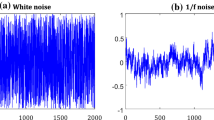Abstract
Complexity and nonlinearity approaches can be used to study the temporal and structural order in heart rate variability (HRV) signal, which is helpful for understanding the underlying rule and physiological essence of cardiovascular regulation. For clinical applications, methods suitable for short-term HRV analysis are more valuable. In this paper, sign series entropy analysis (SSEA) is proposed to characterize the feature of direction variation of HRV. The results show that SSEA method can detect sensitively physiological and pathological changes from short-term HRV signals, and the method also shows its robustness to nonstationarity and noise. Thus, it is suggested as an efficient way for the analysis of clinical HRV and other complex physiological signals.
Similar content being viewed by others
References
Task Force of the European Society of Cardiology and the North American Society of Pacing and Electrophysiology. Heart rate variability, standards of measurement, physiological interpretation, and clinical use. Circulation, 1996, 93: 1043–1065
Bogaert C, Beckers F, Ramaekers D, et al. Analysis of heart rate variability with correlation dimension method in a normal population and in heart transplant patients. Auton Neurosci, 2001, 90: 142–147
Bian C H, Ning X B. Evaluating age-related loss of nonlinearity degree in short-term heartbeat series by optimum modeling dimension. Physica A, 2004, 337: 149–153
Bian C H, Ning X B. Nonlinearity degree of short-term heart rate variability signal. Chinese Sci Bull, 2004, 49: 530–534
Ivanov P C, Amaral L A N, Goldberger A L, et al. Multifractality in human heartbeat dynamics. Nature, 1999, 399: 461–465
Li J, Ning X B. The base-scale entropy analysis of short-term heart rate variability signal. Chinese Sci Bull, 2005, 50: 1269–1273
Pincus S M. Approximate entropy as a measure of system complexity. Proc Natl Acad Sci USA, 1991, 88: 2297–2301
Staniek M, Lehnertz K. Symbolic transfer entropy. Phys Rev Lett, 2008, 100: 158101
Costa M, Goldberger A L, Peng C K. Multiscale entropy analysis of biological signals. Phys Rev E, 2005, 71: 021906
Martins J F, Santos P J, Pires A J, et al. Entropy-based choice of a neural network drive model. IEEE Trans Ind Electr, 2007, 54: 110–116
Pincus S M. Approximate entropy as an irregularity measure for financial data. Econometric Rev, 2008, 27: 329–362
Hao B L. Characterization of complexity and “The Science of Complexity” (in Chinese). Sci Magaz, 1999, 51: 3–8
Daw C S, Finney C E A, Tracy E R. A review of symbolic analysis of experimental data. Rev Sci Instrum, 2003, 74: 915–930
Wessel N, Ziehmann C, Kurths J, et al. Short-term forecasting of life-threatening cardiac arrhythmias based on symbolic dynamics and finite-time growth rates. Phys Rev E, 2000, 61: 733–739
Guzzetti S, Borroni E, Garbelli P E. Symbolic dynamics of heart rate variability: A probe to investigate cardiac autonomic modulation. Circulation, 2005, 112: 465–470
Shannon C E. A mathematical theory of communication. Bell Syst Tech, 1948, 27: 379–423
Goldberger A L, Amaral L A N, Glass L, et al. PhysioBank, physioToolkit, and physioNet: Components of a new research resource for complex physiologic signals. Circulation, 2000, 101: e215–e220
Iyengar N, Peng C K, Morin R, et al. Age-related alterations in the fractal scaling of cardiac interbeat interval dynamics. Am J Physiol, 1996, 271: 1078–1084
Eckman J P, Ruelle D. Fundamental limitations for estimation dimensions and Lyapunov exponents in dynamical systems. Physica D, 1992, 56: 185–187
Ning X B, Bian C H, Wang J, et al. Research progress in nonlinear analysis of heart electric activities. Chinese Sci Bull, 2006, 51: 385–393
Beckers F, Verheyden B, Aubert A E. Aging and nonlinear heart rate control in a healthy population. Am J Physiol Heart Circ Physiol, 2006, 290: 2560–2570
Author information
Authors and Affiliations
Corresponding authors
Additional information
Supported by the National Natural Science Foundation of China (Grant Nos. 60501003, 60701002) and Colleges Oriented Provincial Natural Science Research Plan of Jiangsu Province (Grant No. 06KJD510138)
About this article
Cite this article
Bian, C., Ma, Q., Si, J. et al. Sign series entropy analysis of short-term heart rate variability. Chin. Sci. Bull. 54, 4610–4615 (2009). https://doi.org/10.1007/s11434-009-0398-6
Received:
Accepted:
Published:
Issue Date:
DOI: https://doi.org/10.1007/s11434-009-0398-6




